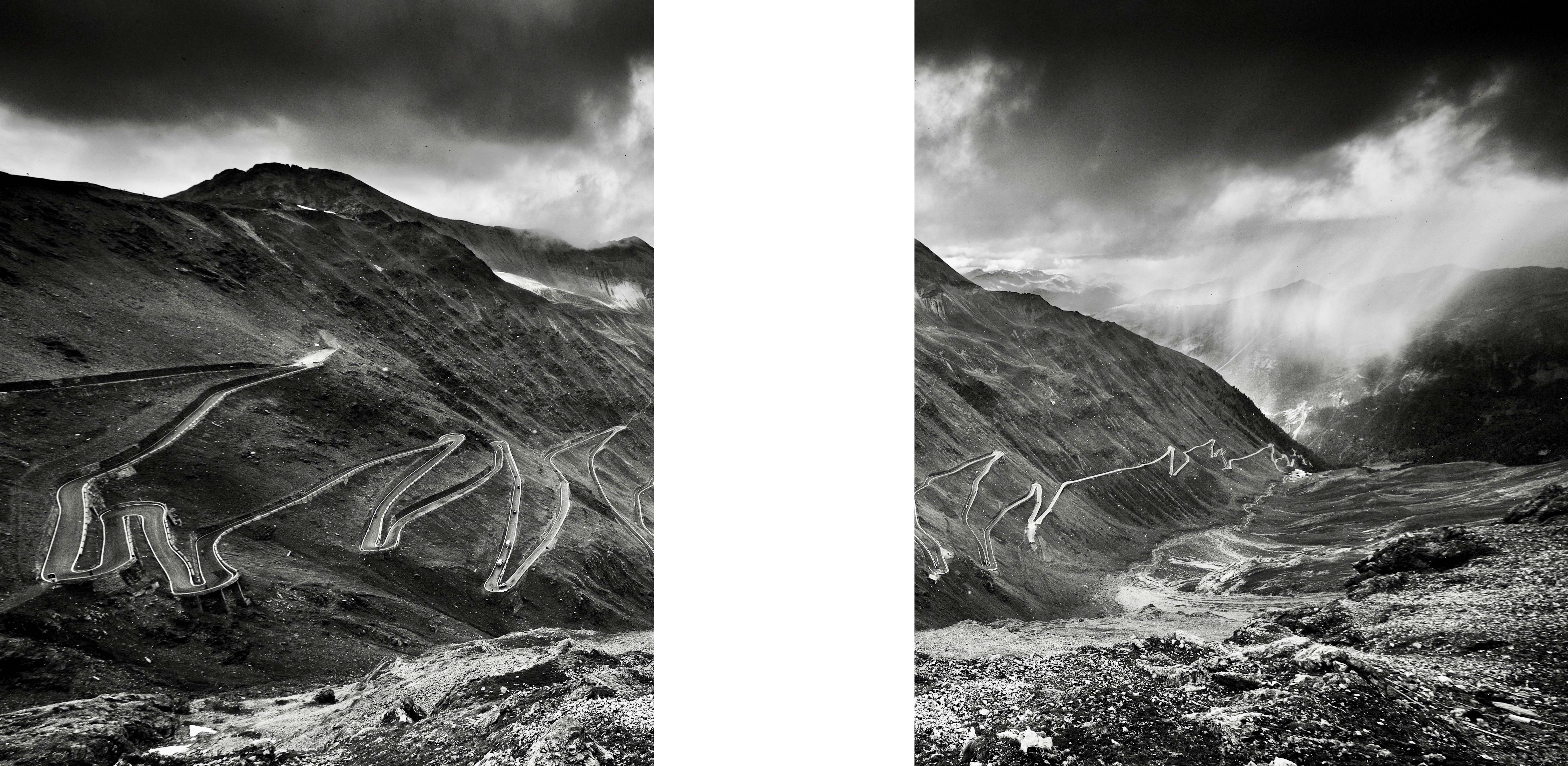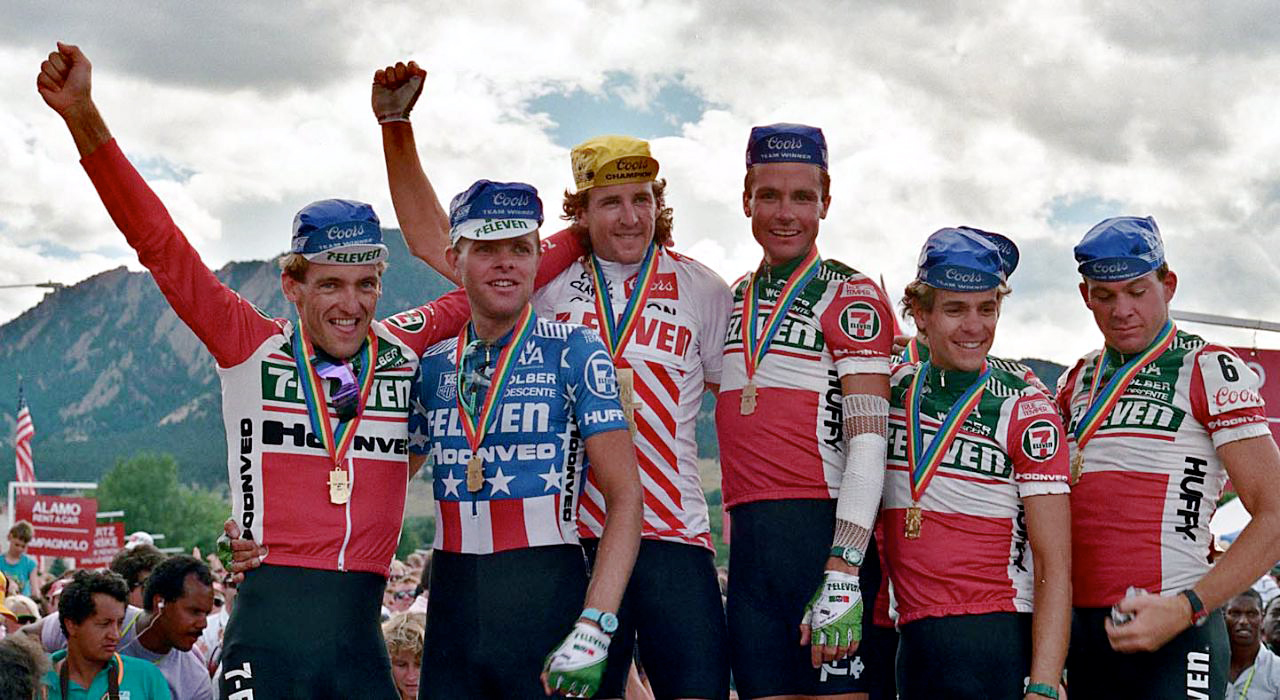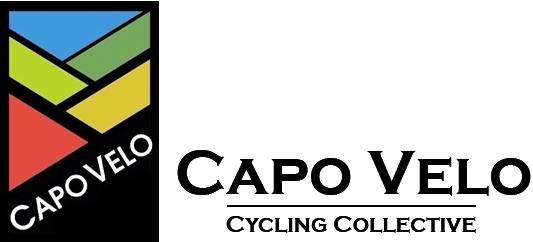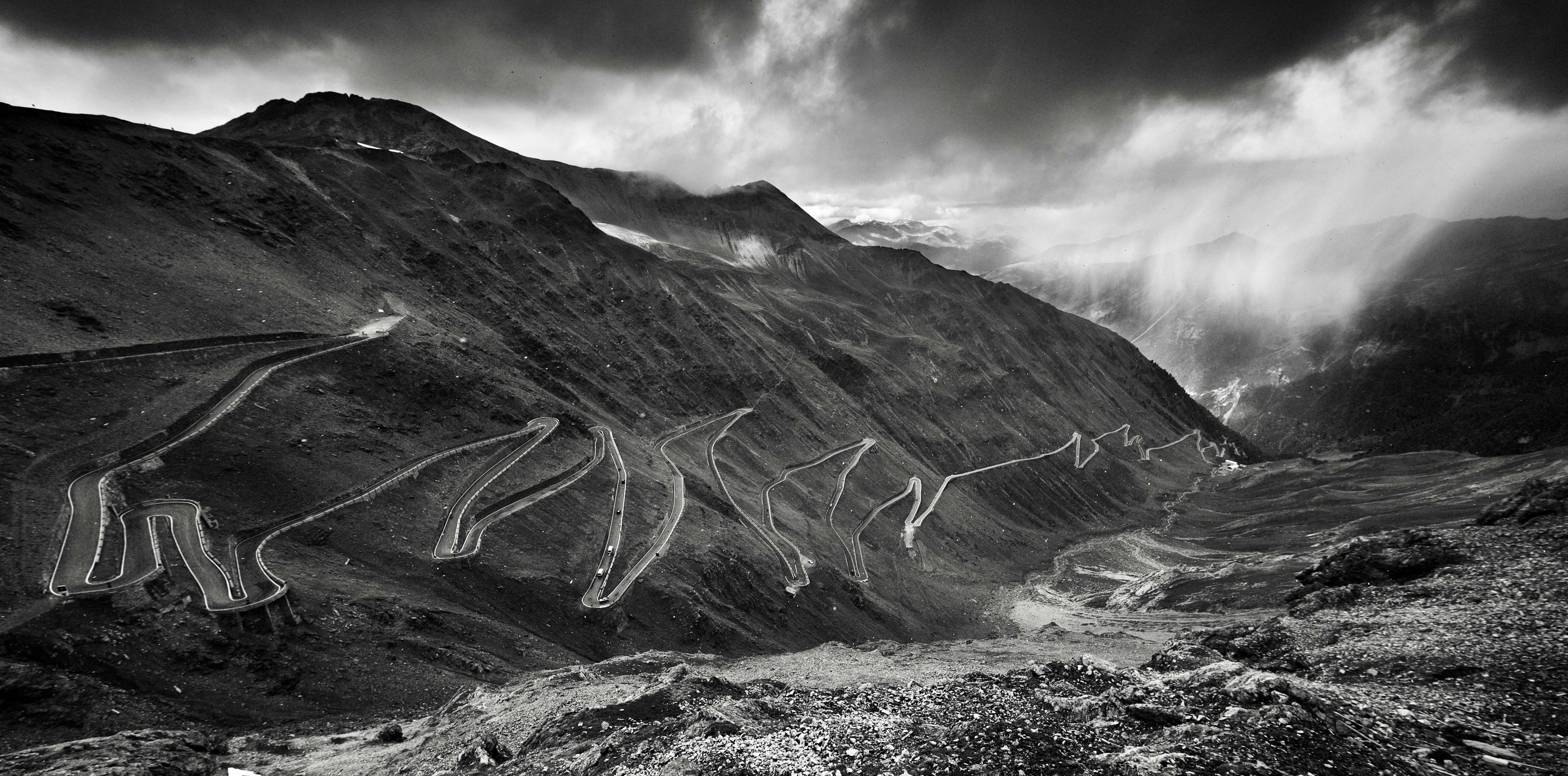

article by Joe Harris and Steve Maxwell of The Outer Line
The Coors Classic introduced pro cycling to a wide audience in the United States, and helped to create many of its early icons – including Greg LeMond, Connie Carpenter, Inga Thompson, and Andy Hampsten. While much of cycling’s fan base today is too young to have seen the race in person, it put the U.S. on the international cycling map in the 1980s, and eventually became one of the top four cycling events in the world. The Coors Classic was, in many ways, the brainchild of the impresario and director Michael Aisner, and the influence of his race, and its innovative approaches to connect with fans and communities, is still being felt today.
Aisner is something of a renaissance man and a seeming perpetual energy machine – and has been involved in a wide range of sporting and entertainment projects throughout his life. One website describes him as “a shotgun blast of worldwide wandering and pure stoke.” He started producing documentaries while still a teenager in Chicago, and even managed to interview Muhammad Ali and Louis Armstrong. He ventured to the Arctic to film and publicize the inhumane killing of baby seals, and with National Geographic he has participated in airlifts to save polar bears in northern Canada. He has produced interactive theater events and live-casts, managed sports programs for ESPN, consulted on a variety of Oscar-nominated films, and is now at work on a feature film about Jane Goodall, and her early days in the jungle amongst the wild African chimps. He has also found time to chase down and film eleven total solar eclipses in all corners of the globe.
Along the way, Aisner also built one of the most successful bike races ever held in the U.S. – an event which has many potential lessons for today’s race organizers and promoters. Although he is quick to share the credit, Aisner, now in his early sixties, clearly provided the energy, passion, and creative approach which characterized the Coors Classic from its earliest days. For those old enough to remember, few will forget the image of Bernard Hinault winning his last ever stage race, rolling into North Boulder Park before 50,000 screaming fans. But even more important, in retrospect, was the high bar of organizational and marketing excellence that the Coors Classic eventually set – creating a business model that was wildly successful in its day, and one which most cycling events since that time have struggled to duplicate.
The Outer Line recently sat down with Aisner at his home in the foothills above Boulder to reminisce about the event, the broader sports and entertainment business, and to identify some of the ideas or lessons which the Coors Classic might provide for the sport’s complicated and challenging situation today. (Editors’ Note: Part 2 of this series will examine some of these ideas and lessons, and will summarize Aisner’s key thoughts and recommendations for race organizers today.)
The race was actually launched in 1975 by Boulder entrepreneur Mo Siegel, the founder of the Celestial Seasonings herbal tea company, to promote interest in bicycling for recreation and alternative transportation. The race was originally called the Red Zinger Classic – named after the company’s flagship tea flavor. Siegel connected with Aisner in 1976 and asked him to try out his PR acumen with the 1977 Zinger. Local interest in the event had grown quickly, and Siegel had been able to bring in some key sponsors early on. He had also initiated a women’s race, helping to build a broader audience, and the event was already being covered on local TV.
Aisner knew “absolutely nothing” about bike racing, but he jumped into the event feet first. “The first thing I did,” he says, “was to hire a film production company to make what we used to call a ‘short’ – a brief docu-film about the race which could be distributed around to mainstream movie theaters.” The first movie short was eleven minutes long, and various subsequent episodes ended up being shown nationwide in theaters, ahead of popular films like Jaws and Breaking Away. “People all across the country were seeing North Boulder Park and the tricky S-curves up on the peak-to-peak highway, with the Rockies as a glorious backdrop,” says Aisner. “It was an exciting, high energy film – ‘Connie Carpenter wins!’ ‘George Mount wins!’” Later, Aisner got well-known ABC Sports announcer Jim McKay to narrate a short film documenting the brutal battle between neo-pro Greg LeMond and the towering 1980 Soviet Olympic gold team; that brought even more attention to the race.
“I feel like that was my first real contribution to cycling,” says Aisner. “I wanted to reach people ‘out of context.’ If we were to grow the race, we had to utilize media outside the traditional cycling sphere, to hook new fans.” Aisner was effectively trying to mainstream the event to the broader American public. In retrospect, perhaps counter-intuitively, the fact that Aisner was almost a complete outsider with no preconceived notions about how to do things, may have been one of the most important strengths that he brought to the event.
In 1979, Siegel determined that the race was costing his company too much money and time. By now, Aisner was working pretty much full time on conceptual development and operational management of the race. “Mo sold me the race for one dollar,” Aisner recollects, “but like usual with Mo, he also had some ideas for a path forward.” Siegel suggested that they drive down the road to Golden, Colorado and try to convince the giant Coors Brewing Company to sponsor the race going forward. “At first I thought Mo was crazy,” Aisner remembers. “I mean, here you have this counter-culture hippie herbal tea company and their dearly beloved bike race, going to this big, bad, right-wing Coors company.”
It wasn’t a simple transition, recalls Aisner, “Coors didn’t even have a sports department to manage their two properties – a hot-air balloon and a Belgian-horse hitch wagon. The race was the catalyst to start a proper ‘big boy’ sports sponsorship division. And look what that is today!” The 1980 race was renamed the Coors International Bicycle Classic, with a sponsorship level about twice as high as Celestial’s – in the $300,000 range.
The overall technical, operational and financial management of the entire race quickly grew increasingly complex that year. He had to make the leap into management from just doing PR and marketing, and says, “I didn’t know anything about race organization – how to deal with police, close the roads, set up the start-finish areas, and all the rest. I had to try to give myself a crash course, and learn whatever I could from the experts.”
Somehow Aisner, in conjunction with a small staff of a half dozen people – along with an expanding army of volunteers – kept the complex logistics of the growing event in check. “For a few years there, I was sort of like a one-man Local Organizing Committee and Medalist Sports wrapped up into one.” He credits east coast race promoter Dave Chauner as being one of his first mentors. “I needed to learn things fast, so I asked if I could just sit down with him and talk, to learn everything I could.” He also cites long-time pro cycling announcer Phil Liggett as another important mentor. “At that time, Phil was a journalist and was promoting the great amateur British Milk Race. So, I just jumped on a plane went over there, followed him around, and picked his brain for everything that I could learn.”
Another way that Aisner tried to “mainstream” the Coors Classic early on was to approach Rolling Stone to be the official magazine for the race – even though the established publications like VeloNews and Bicycling were already involved. When skeptical Rolling Stone editors asked why they should be interested, Aisner convinced them that cycling was a “rock n’ roll” sport. “It’s youthful, it’s fast, it’s colorful, it’s dangerous and it’s international. Rolling Stone basically owned the youth market in those days. Everybody read it, and I wanted that youth appeal.” The publication agreed, publishing an insert in its magazine about the race for the next three years. By that time, the race had developed quite an eclectic network of sponsors – Rolling Stone, BMW, NBC Sports, Coors, Southland 7-Eleven – but Aisner focused on integrating their marketing and sponsorship efforts to cooperate and work together.
Aisner gained confidence and began to diversify and grow the race. First, he started to expand the event out of Colorado and into a longer stage race format, covering several other western states. He looped in other sports-mad and mainstream locations like Vail, Aspen, and San Francisco, California, and eventually even Hawaii. To push the competitive boundaries, Aisner convinced the UCI to let pros compete against the amateurs, a formula he says “was the single most intriguing aspect of the Coors Classic, and makes the race a unique part of U.S. cycling history.” The race became the place where many future champions burst into the spotlight: future Tour de France stars like Australian Phil Anderson, Colombian Lucho Herrera, Canadian Steve Bauer, and Mexican Raul Alcala have credited the Coors as a key career catalyst.
He also emphasized the women’s side of the event, bringing in more European women to compete against the dominant American racer Connie Carpenter. “Connie was brutally focused,” says Aisner, “and the tougher the competition, the stronger she raced.” The Classic became the biggest race in the world for women. The women mostly raced the same courses as the men, some with shorter race distances, and the prize money was nearly equal.
The event quickly grew. Aisner felt the sport had the ingredients to be a hot and attractive sport with a distinctive American personality – and he tried to think of every possible way to push it out to the public. “It was a constant effort to try to expose the race, beyond the normal cycling fans and aficionados.” By the early 1980s, all three Denver TV stations, as well as ESPN, were covering the race. “During race week, the Denver NBC affiliate even delayed The Tonight Show for five minutes – just so they could do an update on the Coors Classic!” says Aisner. “That’s the kind of attentive coverage we were starting to get; it rivalled or even exceeded some pro franchises.”
Greg LeMond arrived at the Classic — and into the U.S. sporting spotlight — as a neo-pro in 1981. President Jimmy Carter had pulled the U.S. team out of the Olympics the previous year, allowing the Soviets to dominate much of the Moscow Games’ competition – and that gave Aisner an idea. He recounts a press conference on the steps of the State Capitol earlier that year with then-Governor of Colorado Dick Lamm and Coors executive Peter Coors. “I kind of threw down the gauntlet to Pete Coors. I turned to the governor, and said ‘I think I’m going to invite the Soviets to race this year.’” The idea caught Coors by surprise. “I mean, these Coors guys were heavy-duty Republicans – Pete’s dad was part of Reagan’s ‘kitchen cabinet,’” remembers Aisner, “but to take this thing to the next level I had to bag the Soviets. So, I challenged them on the steps that day to come over here and meet the pros head-on!”
The Soviets accepted the invitation, and later, so did the East German team. But the only way to communicate with the Eastern Bloc was by sending telexes and cables, and “we had to do that down at the Coors brewery,” laughs Aisner. “It felt a tad awkward for us to be telexing the communists from Coors!” “A few weeks before the race the FBI came around,” says Aisner. “They expected the Soviets to try to defect, and they were instructing us on procedures for dealing with that.” The event garnered international attention as more pros committed to that edition. “It was sort of this huge, titanic clash between east and west and we had media credential requests from all over the world,” says an animated Aisner. Once again, Aisner’s nose for the market, and instincts for attracting the public proved correct: the Cold War athletic stand-off brought in a new and wider range of fans for the race — and although the Soviets won the overall team ranking, LeMond took home the winner’s red jersey.
The management and strategic direction of the race may have been an unorthodox collaboration between Aisner and Coors, but he doesn’t hesitate to give the company credit for helping to grow the scope and visibility of the event. “I pushed them hard, but almost every time I brought them a new idea, they considered it,” he says. “Coors represented a real field day for me, and for the event. I just kept pushing the envelope, and there was a great level of support for us in Coors Sports. Everything that I tested seemed to work, and so I just kept going.”
The 1981 event was a turning point for the Coors Classic, and Aisner’s next big challenge was to try to develop broader national television coverage. “I was pushing everybody to pick it up – I kept trying to tell them that here is a fresh, intense, personality-heavy sport and a race in rarified air, rife with potential danger and good TV angles.” But the national television executives were skeptical. “The CBS guys told me there was no way to cover the sport for an American audience, and to come back when I figured it out,” remembers Aisner. So he took the initiative, and went off to the World Championship in Czechoslovakia later that year, and ended up bringing home photos of a key innovation which changed everything.
While observing the Worlds, he saw how motorcycle cameramen had mounted a swivel device on the back of their motorcycles, “so that the cameramen could shoot backwards into the faces of the riders. All the TV guys in New York had ever seen were cameras following the race, shooting a bunch of asses! Of course it wasn’t interesting!” Aisner convinced BMW to give him two top-of-the-line motorcycles which he then fabricated with swivel seats and camera gear boxes, and took photos back to the CBS Sports guy in New York, along with some film from Europe. “They said, ‘holy shit’ – this might just work,” recalls Aisner, and signed the race to CBS.
There were other innovations during this time. The race started a merchandising division, which quickly grew larger than the race itself. Hats, banner, jerseys, t-shirts and various other memorabilia for the Coors Classic quickly sold. “We generated monstrous numbers for those days,” says Aisner. The merchandise division brought in as much as $1.5 million by the mid-1980s; the group had a full catalog in wide distribution, and employed more people than the actual race division. “We had more than $100,000 of sales even in Japan,” says Aisner. “Coors was heavy into licensing – they were ready to license most anything. We ended selling over thirty unique race-branded products to cycling and sports stores, as well as mainstream grocery and drugstore retailers.”
Throughout the era, Aisner remained focused not so much on trying to make the Coors Classic a big cycling event, as on making it one of America’s great entertainment events. Expanding the race into San Francisco provided the sport one of its iconic moments — but one that almost didn’t happen. While Coors liked most of the ideas Aisner proposed, they were resistant to taking the race to the unfriendly turf at Fisherman’s Wharf – all of the docks were heavily unionized, and Coors was known as a virulently anti-union company. “We’re not very well liked out there’ Pete Coors told me,” recalls Aisner. “’They do not sell Coors on Fisherman’s Wharf or in much of San Francisco.’” Although Aisner recognized it as a serious challenge, he told Coors that he thought the race was bigger than the anti-Coors sentiment, especially given his plans to bring the great French rider Bernard Hinault and Greg LeMond here for the first time.
Coors didn’t stop the Classic staff from going to San Francisco, but Aisner and his tech director Don Hobbs had an interesting reception in the process. “We had one big, gold-chained Italian restaurant owner pull a Khrushchev on us, banging his shoe on the table, and saying ‘over my dead body will you ever bring anything Coors down here to the wharf.’” One Coors distributor that they talked to, leaned back in his chair, says Aisner, “and pointed to a hole in the wall above his desk. ‘That was a bullet intended for me. Welcome to San Francisco, gentlemen. I suggest you rethink this.’ These guys were serious players, but so were we.”
Aisner and Hobbs audaciously told the skeptics that people would show up from all over the west in huge numbers. And the plan worked – the San Francisco start along Fisherman’s Wharf and up to Coit Tower was a massive success, beyond anything they could imagine. The same route has been emulated in more recent years by the Tour of California. “And Coors beer got back on a number of local taps!”
The Coors Classic eventually lost the company’s support after the 1988 edition, when a new brand manager wanted to “do his own thing.” Aisner got the news from a reporter while he was running through an airport, and then spent most of the fall and winter of 1988 in New York City frantically trying to pin down new major title sponsor. A deal with the Nuprin parent company fell through at the final contract signing. Aisner then had even a bigger deal firmed up with Dodge Motors, but a few days before that deal was to close, parent Chrysler CEO Lee Iacocca announced tens of thousands of layoffs and, famously, that he was cutting his own pay to one dollar a year. The sponsorship deal collapsed days later. By then, the race was in danger of losing its position on the international race calendar. Eventually, Aisner had to acknowledge that the race had run its course. Like so many cycling events, despite its long record of success and innovation, the Coors Classic folded due to lack of sponsorship dollars.
Many races have come and gone since that time – most of them struggling economically and typically only lasting a few years. Exceptions include the Tour of California, now in its twelfth year, or, as Aisner points out, the more volunteer-staffed and regionally popular races like the Redlands Classic, Tour of the Gila, and Minnesota’s Nature Valley/Northstar Grand Prix race. But the Coors Classic represents the golden age of cycling in the United States in many respects – and we should ask what lessons it can suggest for today’s scattered and economically challenging landscape.
Michael Aisner clearly brought a unique combination of creativity, passion, and boundless energy which helped make the event successful. He compares his role to that of an orchestra leader. “My job was really to carry the vision, challenge the race to grow and never be stale and to keep everybody productive and happy by building loyalty. But I had a lot of qualified and very talented people; many of them are still in the sport today.” Going on, he says, “I know it’s an overused cliché, but we were really a family. Everybody cared about making the event better – many returned a few years ago for a huge “family” reunion.”
When pressed about the key reasons for the Classic’s success, he comments, “You can’t really say that we were thinking outside the box … there wasn’t even any ‘box’ then. We were just sort of creatively vamping as we went.” But a key theme he repeatedly returns to is that idea of thinking of a cycling event as entertainment – like a precursor to today’s reality TV shows.
Remarkably, the Coors Classic never had a budget of much over $1 million, even for a 16-day race at the time. And it never lost money. In those days TV paid a rights fee, and the race received a further theatrical rights fee from Warner Bros to film segments of its Kevin Costner-headlined film, American Flyers. Cities paid a reasonable amount, and fronted hospitality for the 300+ race entourage. Year-round merchandise sales contributed all profits to the race operating budget and the staff was paid moderate salaries. It was one of the sport’s major professional global events, and although Aisner says he “never really made any money of note in the sport,” he clearly relishes his role and legacy in building and enriching American cycling. In 2005, he was inducted into the U.S. Cycling Hall of Fame.
He worries that some race promoters today may be getting too greedy, and that some of the problems we see today result from the trend to separate ownership and management of events. “I’m afraid that some promoters today opt to do what’s easiest, rather than figuring out a way to do what’s right,” he says. But spend a few minutes with Michael Aisner, and you will find that he is still passionately interested in the sport, and eager to have a voice in addressing the challenges pro cycling faces today.
(Editors’ Note: In an upcoming article, we will examine the key drivers and operating approaches which brought success to the Coors Classic, and how those underlying principles might be utilized and implemented by race organizers in the U.S. today.)






